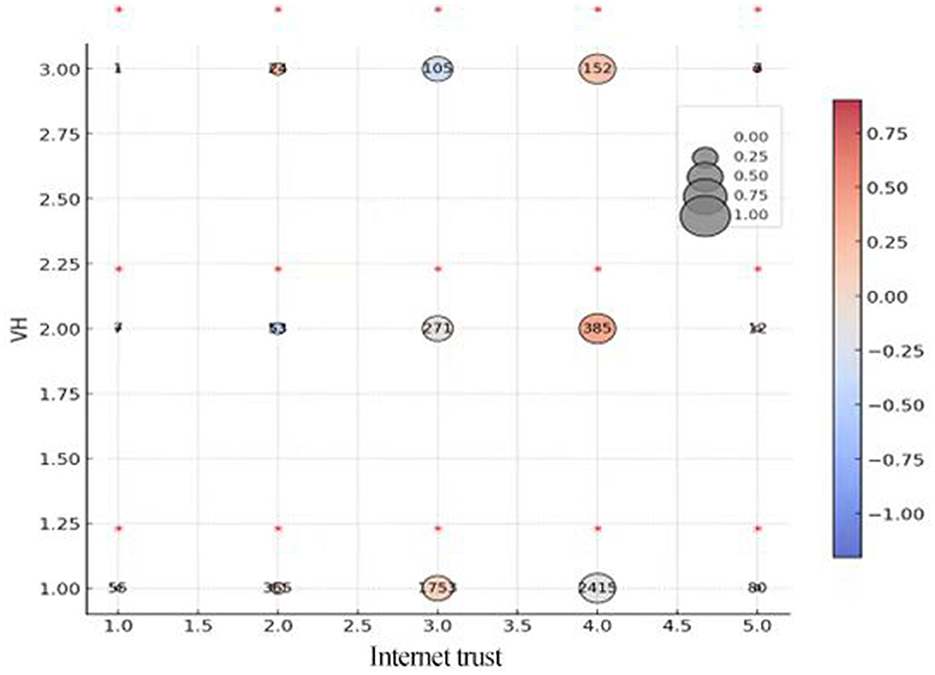- 1School of Public Health, Zhejiang Chinese Medicine University, Hangzhou, Zhejiang, China
- 2Zhongnan Hospital of Wuhan University, Wuhan, Hubei, China
- 3Shandong Cancer Hospital and Institute, Shandong First Medical University and Shandong Academy of Medical Sciences, Jinan, Shandong, China
A Correction on
Understanding vaccine hesitancy through the lens of trust and the 3C model: evidence from Chinese General Social Survey
by Dong B, Xu H, Qi Y and Li Y (2025). Front. Public Health. 13:1671457. doi: 10.3389/fpubh.2025.1671457
There was a mistake in affiliation 1 as published. Affiliation “School of Public Health, Zhejiang Chinese Medicine University, Hangzhou, Zhejiang, China” was erroneously given as “School Public Health, Zhejiang Chinese Medicine University, Hangzhou, Zhejiang, China”.
There was a mistake in Figure 6(e) as published. The corrected Figure 6(e) appears below.

Figure 6. Level of vaccine hesitation and type of trust. This figure shows a bar graph and 5 contingency tables that follow the scale located in the upper right section of the figure. (a) Respondents' approach to COVID-19 vaccines. (b) Distribution of vaccine hesitancy on Generalized trust. (c) Distribution of vaccine hesitancy on government trust. (d) Distribution of vaccine hesitancy on doctor trust. (e) Distribution of vaccine hesitancy on internet trust. The numbers inside the circles show the absolute frequency, the size of the circle indicates the proportion relative to the level of VH, and the color of the circle shows the value of the standardized residuals of the Chi-squared for each cell. The standardized residuals whose value is higher than 2 or lower than−2 are considered as significant differences and are highlighted with an asterisk above the circle.
There was a mistake in the caption of Figure 6 as published. The corrected caption of Figure 6 appears below.
The original version of this article has been updated.
Publisher's note
All claims expressed in this article are solely those of the authors and do not necessarily represent those of their affiliated organizations, or those of the publisher, the editors and the reviewers. Any product that may be evaluated in this article, or claim that may be made by its manufacturer, is not guaranteed or endorsed by the publisher.
Keywords: trust, vaccine hesitancy, COVID-19, psychological antecedent, China
Citation: Dong B, Xu H, Qi Y and Li Y (2025) Correction: Understanding vaccine hesitancy through the lens of trust and the 3C model: evidence from Chinese General Social Survey 2021. Front. Public Health 13:1730651. doi: 10.3389/fpubh.2025.1730651
Received: 23 October 2025; Accepted: 28 October 2025;
Published: 11 November 2025.
Edited and reviewed by: Lei Shi, Guangzhou Medical University, China
Copyright © 2025 Dong, Xu, Qi and Li. This is an open-access article distributed under the terms of the Creative Commons Attribution License (CC BY). The use, distribution or reproduction in other forums is permitted, provided the original author(s) and the copyright owner(s) are credited and that the original publication in this journal is cited, in accordance with accepted academic practice. No use, distribution or reproduction is permitted which does not comply with these terms.
*Correspondence: Yifan Li, bHlmMjAyMDE3N0AxNjMuY29t
†These authors have contributed equally to this work and share first authorship
 Bo Dong
Bo Dong Hengxuan Xu2†
Hengxuan Xu2† Yuantao Qi
Yuantao Qi Yifan Li
Yifan Li